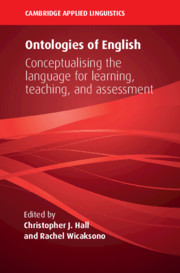Book contents
- Ontologies of English
- The Cambridge Applied Linguistics Series
- Ontologies of English
- Copyright page
- Dedication
- Contents
- Figures
- Tables
- Contributors
- Series Editors’ Preface
- Acknowledgements
- Transcription Conventions
- Part I Introduction
- 1 Approaching Ontologies of English
- 2 An Ontological Framework for English
- Part II English in/for L2 Learning and Teaching
- Part III English in Schools
- Part IV Assessing English
- Part V English in Lingua Franca Contexts
- Part VI English and Social Practice
- Part VII Commentary and Conclusions
- Index
- References
2 - An Ontological Framework for English
from Part I - Introduction
Published online by Cambridge University Press: 24 December 2019
- Ontologies of English
- The Cambridge Applied Linguistics Series
- Ontologies of English
- Copyright page
- Dedication
- Contents
- Figures
- Tables
- Contributors
- Series Editors’ Preface
- Acknowledgements
- Transcription Conventions
- Part I Introduction
- 1 Approaching Ontologies of English
- 2 An Ontological Framework for English
- Part II English in/for L2 Learning and Teaching
- Part III English in Schools
- Part IV Assessing English
- Part V English in Lingua Franca Contexts
- Part VI English and Social Practice
- Part VII Commentary and Conclusions
- Index
- References
Summary
What is there in the world that we refer to as ‘the English language’? Is it more than one thing? If so, how many? And what is their ontological status? For those of us engaged in researching and teaching what we call English, these are fundamental questions, yet they are seldom posed. In addressing them explicitly here, I aim to provide academics, teachers, and policy makers with some conceptual tools and arguments for a deeper reflection on the nature of English, with a view to ultimately benefiting learners and users.
Keywords
- Type
- Chapter
- Information
- Ontologies of EnglishConceptualising the Language for Learning, Teaching, and Assessment, pp. 13 - 36Publisher: Cambridge University PressPrint publication year: 2020
References
- 8
- Cited by

